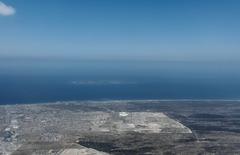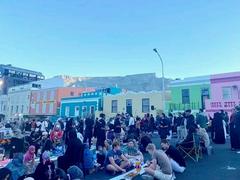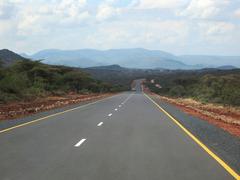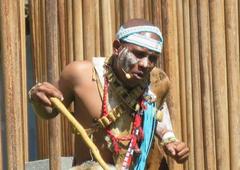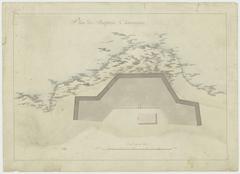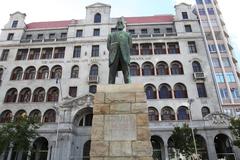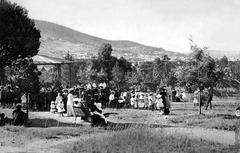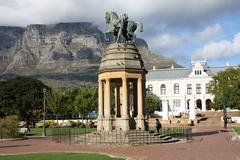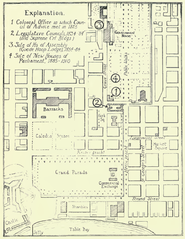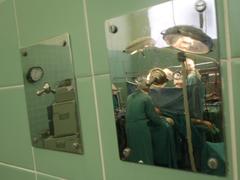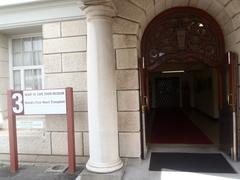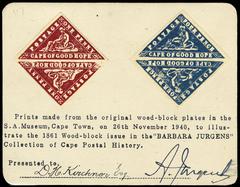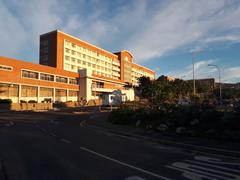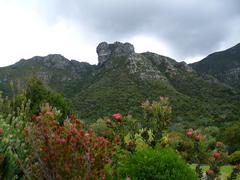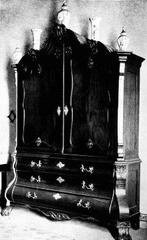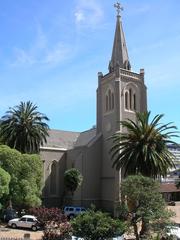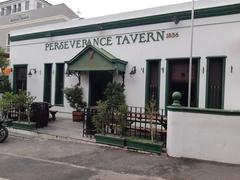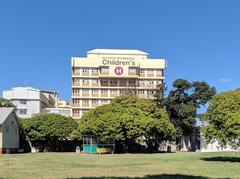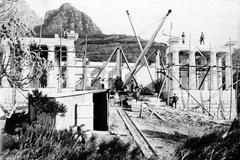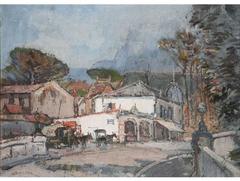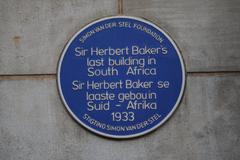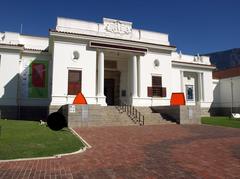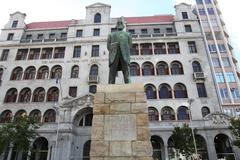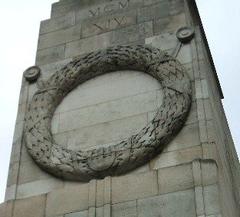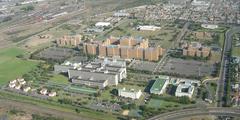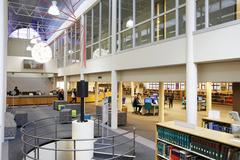Disa Park Cape Town: Visiting Hours, Tickets, and Complete Guide to Historical Sites
Date: 14/06/2025
Introduction: Disa Park in Cape Town – History and Significance
Nestled at the foot of Table Mountain in Cape Town’s Vredehoek suburb, Disa Park is an unmistakable architectural landmark. Completed in 1970 and designed by Tony Esmund White, the complex comprises three cylindrical high-rise towers—Blinkwater, Platteklip, and Silverstroom. These towers are a prime example of Brutalist architecture, celebrated for their raw concrete forms and pioneering use of prefabricated construction techniques. Although Disa Park is primarily residential and not open for public tours, its controversial presence has made it a subject of debate, affection, and curiosity within Cape Town’s urban history. The towers reflect not only post-war housing demands and modernist architectural trends but also echo the city’s complex socio-political landscape during apartheid.
Visitors can experience Disa Park’s striking silhouette from surrounding public spaces, especially along the hiking trails of Platteklip Gorge and Devil’s Peak, which offer sweeping panoramas of Table Mountain and the city below. The area also serves as a convenient starting point for exploring other historic and cultural sites, such as the Castle of Good Hope, Bo-Kaap, and the V&A Waterfront (Cape Town Etc, VISI, Cape Town Tourism).
Contents
- What is Disa Park?
- Architectural Vision and Construction
- Design Features and Living Experience
- Social and Technological Impact
- Integration with Cape Town’s Landscape
- Visiting Disa Park: Practical Info
- Hours, Tickets, and Access
- Guided Tours and Best Times to Visit
- Safety and Local Amenities
- Nearby Attractions and Activities
- Accommodation in Vredehoek and City Bowl
- Frequently Asked Questions (FAQ)
- Summary and Recommendations
- References
What is Disa Park?
Disa Park consists of three distinctive cylindrical towers—Blinkwater, Platteklip, and Silverstroom—rising prominently from the Vredehoek neighborhood. Conceived during the 1960s and completed in 1970, these towers embodied the push for modernist, high-density housing in a rapidly growing Cape Town. Their controversial design has earned them a variety of nicknames, from “Tampon Towers” to “Pepper Pots,” reflecting the city’s ambivalence toward their imposing presence.
Architectural Vision and Construction
Disa Park was constructed by the South African firm Murray & Roberts (Cape Town Etc). At the time, its use of industrialized, prefabricated concrete panels was innovative, allowing for efficient assembly and cost savings. Each tower stands about 55 meters (17 stories) tall, with a diameter of 24.38 meters. The circular design was chosen to maximize panoramic views, reduce wind resistance, and provide a quiet, private living environment.
Design Features and Living Experience
Each of the 287 apartments is arranged around a central core of elevators and stairs. The towers’ cylindrical shape offers residents 360-degree vistas of Table Mountain, the city, and Table Bay. Vinyl flooring and other materials were selected for noise reduction. The design also helps mitigate the fierce winds that blow down from the mountain, though residents are still advised to secure windows during storms.
Social and Technological Impact
Disa Park’s construction reflected both the modernist ideals of the era and the apartheid regime’s spatial planning, with initial residency restricted to white South Africans. Over time, the towers have become home to a diverse, close-knit community notable for their civic engagement, such as organizing support during the Table Mountain fire in April 2021.
Technologically, the towers’ prefabrication techniques influenced future South African high-rise construction, and their structural resilience has ensured their continued use for over 50 years.
Integration with Cape Town’s Landscape
Disa Park sits within the buffer zone of Table Mountain National Park, offering immediate access to hiking trails and outdoor recreation. While some view the towers as a blight on the natural landscape, others argue they represent a unique fusion of modern architecture and environmental adaptation.
Visiting Disa Park: Practical Information
Hours, Tickets, and Access
- Access: Disa Park is a private residential complex. The towers themselves are not open to public tours or casual visitors.
- Tickets: No tickets are required to view the towers from public streets or trails.
- Best Viewing Times: Early morning or late afternoon for optimal light and cooler weather.
- Getting There: Easily accessible by car, rideshare, or MyCiTi bus routes. Street parking is available but restricted within the complex.
Guided Tours and Best Times to Visit
Guided walking and hiking tours of Vredehoek and the Table Mountain foothills often include Disa Park as a point of interest, providing insights into its architectural and social history. These tours typically operate during daylight and require advance booking (VISI).
Safety and Local Amenities
Vredehoek is considered one of Cape Town’s safer neighborhoods (ES Cape Town). Standard precautions apply: hike in groups, avoid isolated areas after dark, and secure valuables. The area features several cafés, bakeries, and the Garden Centre shopping complex for refreshments and public restrooms.
Nearby Attractions and Activities
- Table Mountain National Park: Access hiking and biking trails directly from Vredehoek (PlanetWare).
- Company’s Garden: Historic park with museums and galleries, 10 minutes by car (PlanetWare).
- Castle of Good Hope: South Africa’s oldest colonial building, 2.5 km away, offering tours and exhibitions (Trek Zone).
- Bo-Kaap: Famous for colorful houses and Cape Malay culture.
- V&A Waterfront: Premier shopping and entertainment hub featuring the Two Oceans Aquarium and Zeitz MOCAA.
- Kirstenbosch National Botanical Garden: A world-renowned botanical garden, 20 minutes by car.
- Clifton and Camps Bay Beaches: Popular white sand beaches, 15–20 minutes’ drive.
Accommodation in Vredehoek and City Bowl
While Disa Park itself does not offer guest accommodation, the greater Vredehoek area features boutique hotels, guesthouses, and self-catering apartments. This location is ideal for travelers seeking a quieter base with easy access to both the city center and Table Mountain (ES Cape Town).
Frequently Asked Questions (FAQ)
Can I enter the Disa Park towers?
No. The towers are private residences; access is restricted to residents and their guests.
Are there guided tours that include Disa Park?
Yes, some architectural and city walking tours include Disa Park as a feature. Advance booking is recommended.
What is the best time to visit for photography?
Early mornings or late afternoons provide the best natural light and city views.
Is Disa Park safe to visit?
Vredehoek is generally safe, but standard city precautions should be observed, especially on mountain trails.
Where can I park?
Street parking is available in Vredehoek. Parking inside the complex is restricted.
Local Tips and Etiquette
- Respect Privacy: Photograph the towers from public areas and trails; do not enter private property.
- Weather: Pack layered clothing. Mountain weather can change rapidly.
- Transport: Rideshare services are reliable; public transport is available but less frequent after dark.
- Cafés: Enjoy local coffee shops and bakeries nearby for a taste of the neighborhood.
Visuals and Media
- [Insert images: Disa Park towers with Table Mountain, views from Platteklip Gorge, and city panoramas with descriptive alt text]
- Interactive map: Location of Disa Park and surrounding attractions.
Essential Contacts
- Emergency: 10111 (police), 112 (mobile)
- Public Transit: MyCiTi Official Site
- Tourist Information: Cape Town Tourism
For more neighborhood insights and travel tips:
The Unconventional Route
ES Cape Town
Summary and Recommendations
Disa Park is a unique fusion of architectural innovation, urban living, and Cape Town’s complex socio-historical fabric. Its iconic cylindrical towers are both a milestone in South African design and a testament to the city’s evolving identity. While public access to the towers is restricted, the surrounding area offers rich opportunities for exploration—panoramic mountain trails, historic sites like the Castle of Good Hope, and vibrant neighborhoods such as Bo-Kaap. Plan your visit for early morning or late afternoon, respect local etiquette, and take advantage of guided tours to maximize your experience. To stay updated on Cape Town’s attractions and travel tips, consider downloading the Audiala app and connecting with local tourism platforms (Cape Town Tourism, Table Mountain National Park Official Site, VISI).
References
- Cape Town Etc – How Cape Town’s Tampon Towers Came to Be
- VISI – Building an Icon: Disa Park
- Cape Town Tourism – Official Cape Town Travel Site
- SANParks – Table Mountain National Park Official Site
- Trek Zone – Disa Park Cape Town
- PlanetWare – Tourist Attractions in Cape Town
- ES Cape Town – Safety and Visitor Tips for Vredehoek
